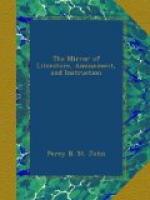[2] The barony of Werke was
given to the family of Ros, Barons of
Hemsley,
in Yorkshire, by Henry I. for the service of two
knights’
fees, and was in their possession till 1399; but in
the
next year was found to belong to Sir Thomas Grey, of
Heton.
It gave title of baron in 1622, to Sir William Grey,
who
died in 1674. The village of Werke, and its ruined
castle,
are
all that remain of the possessions of the barony; the
former
consisting of a miserable cluster of thatched cottages;
the
latter of mere fragments of ashlar work, near its
foundations
and lines of its moat. The village stands on the
margin
of the Tweed: and the castle is celebrated in
the
border
annals. Heton, of which we have just spoken, in
Edward
the
First’s reign, belonged to William de Heton;
and in the
next
reign, to Sir Thomas Grey, captain of Norham Castle.
Sir
John
Grey, of Heton, in 1420, was graced with the order
of St.
George,
or the Garter; and from him the estate descended to
the
Tankervilles.
The father of Earl Grey was Sir Charles Grey, who entered the army at an early age, had a command in the American war, and commanded in chief the military forces in the expeditions against the French West India Islands, the successful result of which was the annexing of Martinique, St. Lucie, Guadaloupe, &c. to our empire. He married, in 1762, Elizabeth, daughter of George Grey, Esq. of Southwick, in Durham, (of a different family,) by whom he had five sons and two daughters. He was created Lord Grey of Howick, in 1801; and Viscount Howick, and Earl Grey, in 1806. He died in the following year, and was succeeded by his son, Charles, second and present earl.
Mr. Grey was born March 13, 1764, and educated at Eton, in the same class with the late Mr. Lambton, (father of the present Lord Durham,) Mr. Whitbread, and others, with whom he afterwards acted in political life. He was then sent to King’s College, Cambridge, where he displayed first-rate abilities. On his leaving the University, he set out on the tour of Europe, though only eighteen years of age. In Italy, he was introduced to the late Duke of Cumberland, in whose household he obtained an appointment. He returned to England in 1786, and soon after his arrival, was, by the interest of his family, returned to parliament for the county of Northumberland, when he joined the Whigs, it has been stated, to the surprise of his family, whose principles were those of Toryism.




